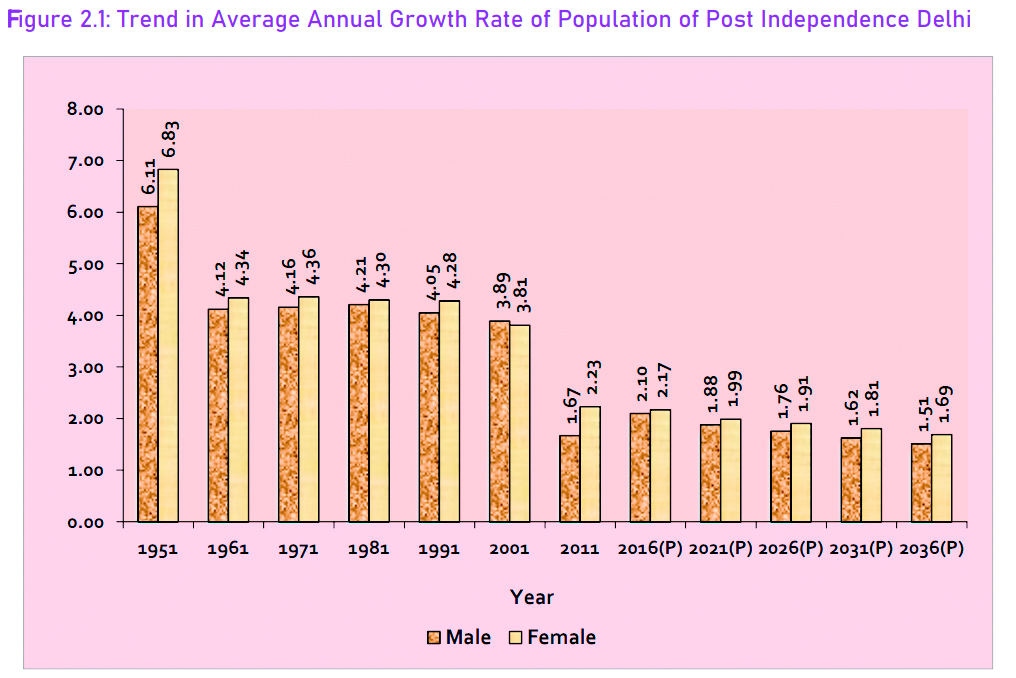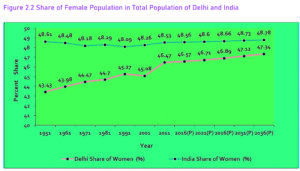
Delhi stands as one of the swiftest-growing cities in the nation. The rapid urbanization has significantly transformed the city’s landscape, shifting from a predominantly rural setting to an increasingly urbanised one. With each successive Census, a growing number of rural villages in Delhi are reclassified as census towns, leading to a decline in both rural population and rural areas within the city.

As per the ‘Women & Men in Delhi 2023’ report released by the Delhi government, the population of the national capital is projected to reach 2.65 crores by the year 2036, with women accounting for 47.34%.
POPULATION TRENDS IN THE CAPITAL
The Population Census remains the sole comprehensive source for gathering data on population characteristics, conducted decennially by the Government of India in collaboration with states. The inaugural synchronized census in India took place in 1881, with the most recent, the 15th in the series, carried out in 2011. According to the 2011 census, Delhi’s population as of March 1, 2011, stood at 16.78 million, a notable increase from the 13.85 million recorded on March 1, 2001.
As per the Census 2011 findings, approximately 97.50 per cent of Delhi’s population resides in urban areas, while the remaining 2.5 per cent resides in rural areas. This urban population encompasses the residents of 110 census towns identified in the 2011 Census.
It is important to note, as per Revenue Department records, that these census towns are situated in the rural expanse of Delhi and are distinct from the officially designated urban areas of the city.
GROWTH OF POPULATION IN DELHI
The population of Delhi has witnessed a consistent annual increase, and the census data highlights significant trends over the years. In the 2011 census, the total female population in Delhi was 7,800,615, with an average exponential growth rate of 2.23%. Comparatively, in the 1951 census, the total female population was 757,534, with an average exponential growth rate of 6.83%. Despite the population’s continuous increase since 1951, the average exponential growth rate has seen a decline.
Projections estimate that by the year 2036, the population of Delhi will reach 26,591,000, with an average exponential growth rate of 1.60%. Within this, the female population is anticipated to be 12,589,000, with an average exponential growth rate of 1.69%. These projections are based on the Report of the Technical Group on Population Projections for India and States 2011-2036, Ministry of Health & Family Welfare, ORGI, published in July 2020.
The percentage share of women in Delhi has also experienced a notable increase post-independence. In 1951, women constituted 43.43% of the population in Delhi, compared to 48.61% in India. Over the years, the share of women in Delhi has steadily risen, reaching 46.47% in 2011, compared to 48.53% in India. This represents a 3.04% increase in the share of women in Delhi from 1951 to 2011. Projections for the year 2036 anticipate a further increase, with the estimated share of women in Delhi at 47.34%, and 48.78% in India.
Examining the decadal growth rate, the period from 2001-2011 recorded a rate of 21.2%, diverging from the trend observed in earlier censuses where the growth rate exceeded 50%, reaching 47% in 2001. This unique trend is attributed to the implementation of employment promotion programs like MGNREGA and welfare schemes for senior citizens and widows by Central and State Governments.
Additionally, the development of NCR priority towns, including Gurgaon, Faridabad, Sonipat, Noida, Ghaziabad, and Meerut, has contributed to reducing migration to Delhi. Despite accounting for only 0.05% of India’s geographical area, Delhi comprises 1.39% of the nation’s population, indicating its significance in demographic terms.
SEX RATIO
The sex ratio, a vital demographic indicator reflecting the socio-economic characteristics of a population, plays a crucial role in understanding gender dynamics. In Delhi, as of the 2011 Census, the sex ratio stood at 868, indicating an improvement from 821 in 2001.
This positive shift over the last decade signifies progress in addressing gender imbalances. To counteract this issue at both the national and state levels, stringent measures have been implemented against female foeticide, accompanied by the complete abolition of sex determination practices during pregnancy.
The improvement in Delhi’s sex ratio is evident in a historical context. In 1951, Delhi’s sex ratio was 768, notably lower than India’s sex ratio of 946. Since then, there has been a continuous positive trajectory, reaching a sex ratio of 868 in the 2011 census, compared to India’s sex ratio of 943. Projections for the year 2036 anticipate further enhancements, with an estimated sex ratio of 899 for Delhi and 952 for India.
These trends reflect ongoing efforts to promote gender equality and address historical disparities in the sex ratio, highlighting the importance of sustained measures to ensure equitable demographic patterns.
According to the report, there is a consistent rise in the city’s population, coupled with noteworthy trends in gender ratios and urban-rural distribution.
However, rising populations also raise a series of problems for the capital city. The burgeoning population in Delhi presents a myriad of challenges that span across urban infrastructure, housing, and environmental sustainability. The city grapples with issues such as severe traffic congestion, prolonged commute times, and escalating air pollution due to the increasing number of vehicles on the road.
Housing shortages and rising property prices are exacerbated by the higher demand, leading to the emergence of informal settlements. Basic infrastructure services, including water supply, sanitation, and electricity, face strain, impacting the overall quality of life.
Unemployment and economic disparities are prevalent, with the job market struggling to keep pace with population growth. Social services, law enforcement, and emergency services may be stretched thin, and the pressure on open spaces and green areas is evident as urbanization progresses.
As Delhi navigates these challenges, strategic urban planning, sustainable development initiatives, and effective governance are imperative to ensure the city’s ability to accommodate its growing population while maintaining a high standard of living for its residents.
Examining the growth trajectory, the projections for 2036 anticipate further growth, emphasizing the need for sustainable urban planning and development strategies.